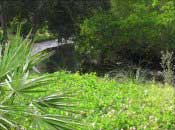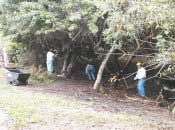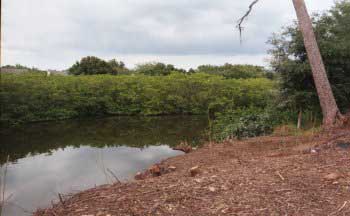
COVERING TAMPA BAY AND ITS WATERSHED |
Our subscribe page has moved! Please visit baysoundings.com/subscribe to submit your subscription request. |
|||||||
In retrospect, it's probably a good thing that the Overlook Homeowners Association didn't know what they were getting into when they started trimming back overgrown Brazilian pepper trees. Even so, two years and 100 tons of branches later, they say they'd do it again - after just a moment's hesitation. "It's nasty stuff," says Joanne Kuzma, one of the volunteers involved in the project since the beginning. "Even now, when I pull up at a stop sign and see Brazilian pepper, I want to get out of my car and start cutting it down." Once a popular landscape plant dubbed Florida holly, Brazilian pepper trees (Schinus terebinthifolius) have become the most dominant invasive species in the state - destroying more habitat than even the infamous melaleuca. Covering an estimated 700,000 acres from Key West north to Cedar Key and Daytona Beach, Brazilian peppers grow quickly with no natural controls so they crowd out native plants that provide habitat and food for native wildlife. At Overlook, a charming neighborhood of 104 townhomes located in Largo adjacent to a tidal creek that runs into Tampa Bay, Brazilian pepper trees had overgrown the community's low-lying fringes. "The lawn service would cut them back so that they weren't in the road, but they were taking over," said Bill Little, project director for 2004. "They had gotten so thick along the creek we couldn't tell where land ended and water started." Ladies with Loppers More than 50 volunteers - ranging from teenagers to seniors in their late 70s - took part in the two-year effort that cleared nearly 500 yards of pepper trees - an expanse equal to five football fields. "The ladies would go in with loppers and we'd cut everything we could reach, then the men would follow with chain saws once they could see exactly where the tree was growing," Kuzma said. Much of the area to be cleared was lowland or marsh, inaccessible with heavy equipment even if they could see where they were going. "One area, back in about 75 feet, had four trees so large that even 20 men couldn't have moved them," adds Jack Lonquist, another long-time participant. "We cut them down, then went in with chains and dragged them out with a four-wheel-drive truck," he said. Working on weekends, often until the middle of the afternoon even during summer months, was brutal but volunteers saw results and kept up the work, Lonquist said. "It's like waxing a car - very hard work but you feel good when you're done." Green is Not Always Good "We spent a lot of time explaining that just because they're green doesn't mean they're good," Little said. At Overlook, quickly replacing pepper trees was important to prevent erosion along the creek banks. With grants from the Tampa Bay Estuary Program and the Southwest Florida Water Management District, residents purchased nearly 300 trees, bushes, groundcovers and grasses. "We worked with experts from the Florida Yards & Neighborhood program who explained the value of using a variety of plantings," notes Millie Tibma, who served as director of the initiative during its first year. The native plants and clearer water have visibly increased wildlife, Little adds. Rabbit populations declined immediately after the land was cleared but are rebounding now. Butterflies flock to native flowers like firebush and mimosa, otters frolic in tidal creeks, and moor hens and wood ducks are taking up residence in the natural landscaping. Fish have returned to the lagoon, where residents can see the bottom for the first time in years. Help is at Hand Although local governments strongly encourage control of Brazilian pepper trees, there's more to cutting them down than just firing up a chain saw. Many Brazilian peppers, including those at Overlook, grow in protected wetlands and individuals or communities must have appropriate permits before they start cutting them down. In fact, that's exactly what happened at Overlook when Millie Tibma starting trimming the trees growing near her back door and the Pinellas County Department of Environmental Management left a card on her door. Over the next two years, residents learned more about the destructive nature of Brazilian peppers and funding available to help defeat them. "It's a perfect example of what we like to see happen with mini-grants," said Nanette Holland, public outreach coordinator for TBEP. "There was an enormous amount of community involvement and education that resulted in eradication of a large stand of peppers." When the city of Largo annexed Overlook last year, they offered to provide the neighborhood with a dumpster and cover landfill costs, Little adds. "Getting rid of what we cut down was the hardest part of this project," he said. The city also recognized the value of what the residents accomplished and plans to clear Brazilian peppers from nearby lands to minimize reinfestation. Even after the pepper trees have been cut down and hauled off, keeping them at bay is an ongoing effort. Stumps must be treated with special herbicides, sometimes two or three times before the tenacious trees finally die. And seeds, spread by birds that love the brilliant red berries, can quickly spring up almost any time of year. "We'll probably be at this forever," says Little, "but we'll just keep after them as long as we have to."
|
||||||||
|
||||||||
|
© 2005 Bay Soundings
|
||||||||




